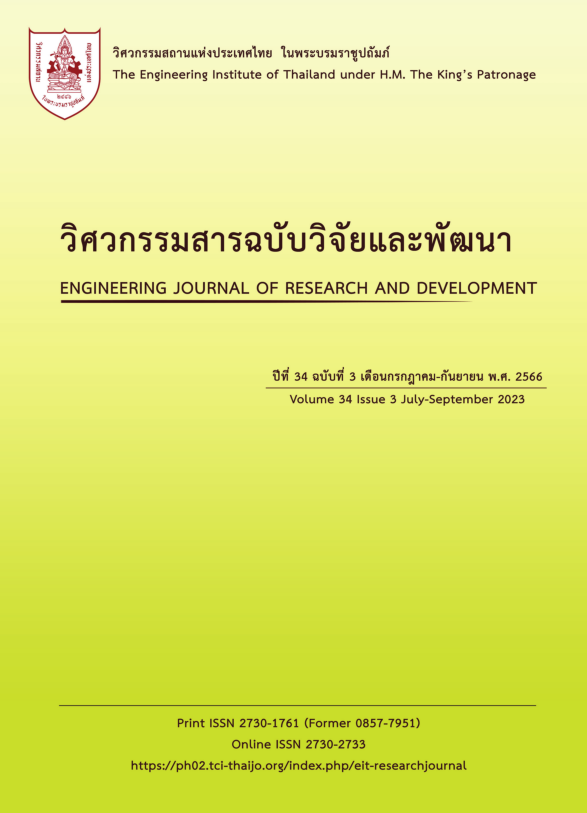APPLICATION OF CYCLEGAN FOR CREATING MODERN THAI HOUSES
Main Article Content
Abstract
Artificial Intelligence (AI) is increasingly influential in shaping the future of technology and trends, including the field of architectural design. Over many years, AI systems for architectural design have been evolved aiming to replace certain levels of human design, but there is still a lack of development in AI models and frameworks for this area, leaving room for improvement. A noticeable gap exists in studies focusing on traditional or vernacular architectural design using AI. This paper represents an initial step in a series of research efforts dedicated to developing deep learning technology capable of designing traditional architecture. The research aims to study the features of architectural design in the context of vernacular architecture, specifically examining traditional Thai homes and determining suitable Generative Adversarial Neural Networks (GANs) for architectural design. This study suggests the application of Generative Adversarial Neural Networks (GANs) in creating designs for specific architectural styles.
Through an empirical investigation into Thai vernacular homes, the paper implements a CycleGAN model in architectural design. Post-training results indicate the potential applicability of the AI model to design modern Thai homes, converting contemporary international houses with traditional Thai features. The key aspects of Thai vernacular architecture chosen by the AI model include a high gable with a top element, a windbreak on the gable, known as "Pan-lom", a Thai-style platform (typically leaving the ground floor as open space), and a wood texture that incorporates color and a Thai-style assembly pattern.
Article Details

This work is licensed under a Creative Commons Attribution-NonCommercial-NoDerivatives 4.0 International License.
The published articles are copyright of the Engineering Journal of Research and Development, The Engineering Institute of Thailand Under H.M. The King's Patronage (EIT).
References
Campo, M. Del et al. Hallucinating Cities - A Posthuman Design Method based on Neural Networks. Proceedings of SimAUD, 2020.
Hassab, A. et al. Generative Design Methodology for Double Curved Surfaces using AI. In: Architecture in the Age of Disruptive Technologies: Transformations and Challenges [9th ASCAAD Conference Proceedings], 2021.
Hillier, B. et al. Creating life: or, does architecture determine anything? Architecture & Comportement/Architecture & Behaviour, 1986, 3 (3).
Hillier, B. et al. The social logic of space. The social logic of space, 1988. DOI: 10.4324/9780429450174-9
Leach, N. Do Robots Dream of Digital Buildings? In: Architectural Intelligence, 2020. DOI: 10.1007/978-981-15-6568-7_4
Chaillou, S. The Advent of Architectural AI - A Historical Perspective. Towards Data Science, 2019, (May).
Huang, W. et al. Architectural drawings recognition and generation through machine learning. In: Recalibration on Imprecision and Infidelity - Proceedings of the 38th Annual Conference of the Association for Computer Aided Design in Architecture, ACADIA, 2018.
Goodfellow, I.J. et al. Generative adversarial nets. In: Advances in Neural Information Processing Systems, 2014. DOI: 10.3156/jsoft.29.5_177_2
Arjovsky, M. et al. Wasserstein generative adversarial networks. In: 34th International Conference on Machine Learning, ICML, 2017.
Zhu, J.Y. et al. Unpaired Image-to-Image Translation Using Cycle-Consistent Adversarial Networks. In: Proceedings of the IEEE International Conference on Computer Vision, 2017. DOI: 10.1109/ICCV.2017.244
Isola, P. et al. Image-to-image translation with conditional adversarial networks. In: Proceedings - 30th IEEE Conference on Computer Vision and Pattern Recognition, CVPR, 2017. DOI: 10.1109/CVPR.2017.632
Rajagopal, A. et al. The Rise of AI and Machine Learning in Construction. Autodesk Research, 2017.
Villaggi, L. et al. Generative Design for Architectural Space Planning. Autodesk Research, 2017.
Chaillou, S. Artificial Intelligence and Architecture, 2022. DOI: 10.1515/9783035624045
Miguel, J. de et al. Deep Form Finding Using Variational Autoencoders for deep form finding of structural typologies. In: 2020. DOI: 10.5151/proceedings-caadesigradi2019_514
Asquith, L. et al. Vernacular architecture in the twenty-first century: theory, education and practice, 2006.
Oliver, P. Enclyclopedia of Vernacular Architecture of the World. Architectural Review, 1998.
Brunskill, R.W. Vernacular architecture: An illustrated handbook. London: Faber and Faber Limited, 2000. DOI: 10.2307/539141
Punpairoj, P. Recalibrating the New Thai Vernacular Architecture. Journal of Architectural/Planning Research and Studies (JARS), 2018, 7 (2), pp. 65–80.
Roonrakwit, P. Thailand and Southeast Asia Oliver, P. (ed.). Encyclopedia of vernacular architecture of the world, 1997.
Horayangkura, V. The architecture of Thailand, change amid continuity: The new challenge in transforming traditions. Asian Studies Publication Series, 2001.
Denpaiboon, C. Transformation by modernization of the traditional waterfront settlements in the context of their coexistence with aquatic environment: A case study of raft house and pillar house in Thailand, 2001.
Pavlides, E. Architectural Oliver, P. (ed.). Encyclopedia of vernacular architecture of the world, 1997.
Jotisalikorn, C. Classic Thai: Design-interior-architecture. Bangkok: Thailand: Asia Books, 2002.
Chaichongrak, R. et al. The Thai house: history and evolution. Bangkok: River Books, 2002.
Choi, H.-H. et al. The Characteristic of Decoration in Central Thai Traditional House. In: Proceeding of Spring/Autumn Annual Conference of KHA. The Korean Housing Association, 2011, pp. 103–108.
Sanjeevi, M. Ch 14.2 Pix2Pix Gan and Cycle Gan. Deep Math Machine learning.ai, 2019. Available from: https://medium.com/deep-math-machine-learning-ai/ch-14-2-pix2pix-gan-and-cycle-gan-55cd84318fb8 [Accessed 24 November 2021]


